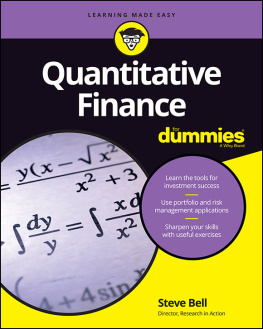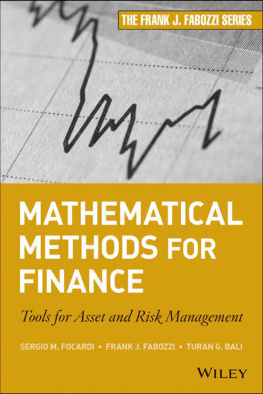THE OXFORD HANDBOOK OF
QUANTITATIVE ASSET MANAGEMENT
OXFORD HANDBOOKS IN FINANCE
SERIES EDITOR: MICHAEL DEMPSTER
THE OXFORD HANDBOOK OF BANKING
Edited by Allen N. Berger, Philip Molyneux, and John O.S. Wilson
THE OXFORD HANDBOOK OF CREDIT DERIVATIVES
Edited by Alexander Lipton and Andrew Rennie
THE OXFORD HANDBOOK OF QUANTITATIVE ASSET MANAGEMENT
Edited by Bernd Scherer and Kenneth Winston
THE OXFORD HANDBOOK OF
QUANTITATIVE ASSET MANAGEMENTEdited by
BERND SCHERER
and
KENNETH WINSTON


Great Clarendon Street, Oxford OX2 6DP
Oxford University Press is a department of the University of Oxford.
It furthers the Universitys objective of excellence in research, scholarship,
and education by publishing worldwide in
Oxford New York
Auckland Cape Town Dar es Salaam Hong Kong Karachi
Kuala Lumpur Madrid Melbourne Mexico City Nairobi
New Delhi Shanghai Taipei Toronto
With offices in
Argentina Austria Brazil Chile Czech Republic France Greece
Guatemala Hungary Italy Japan Poland Portugal Singapore
South Korea Switzerland Thailand Turkey Ukraine Vietnam
Oxford is a registered trade mark of Oxford University Press
in the UK and in certain other countries
Published in the United States
by Oxford University Press Inc., New York
Oxford University Press 2012
The moral rights of the authors have been asserted
Database right Oxford University Press (maker)
First published 2012
All rights reserved. No part of this publication may be reproduced,
stored in a retrieval system, or transmitted, in any form or by any means,
without the prior permission in writing of Oxford University Press,
or as expressly permitted by law, or under terms agreed with the appropriate
reprographics rights organization. Enquiries concerning reproduction
outside the scope of the above should be sent to the Rights Department,
Oxford University Press, at the address above
You must not circulate this book in any other binding or cover
and you must impose the same condition on any acquirer
British Library Cataloguing in Publication Data
Data available
Library of Congress Cataloging in Publication Data
Data available
Typeset by SPI Publisher Services, Pondicherry, India
Printed in Great Britain
on acid-free paper by
MPG Books Group, Bodmin and Kings Lynn
ISBN 978-0-19-955343-3
1 3 5 7 9 10 8 6 4 2
SERIES EDITORS PREFACE
Recently two series of Oxford Handbooks covering financial topics have been merged into one under a single editorship those in Finance found under Business and Economics and those in Quantitative Finance found under Mathematics. This is as it should be, for in spite of all the accusations regarding their role in the recent crisis and recession, financial services are both necessary and critical to the successful development of a global economy facing environmental and pension crises on top of the current one. It can also be argued that banking, insurance, and fund management are the last post war industries to go high tech and that the esoteric topics involved need exposition to a more general audience than simply that of their creators. The aim of this handbook series is therefore to cover recent developments in financial services, institutions, and markets in an up to date, accurate, and comprehensive manner which is clear and comprehensible to the interested reader. This will be achieved by careful choice of editors for, and exacting selection of contributors to, each handbook.
It is my hope that over time the volumes in this series will help to create a better understanding of financial topics by the educated public, including financial services managers, regulators, and legislators. Such an understanding appeared to be lacking in the run-up to the recent crisis, but it will be crucial to successful management of the global economy in the future.
Michael Dempster
ACKNOWLEDGMENTS
This Handbook was commissioned by Sarah Caro at Oxford University Press in 2008. At Oxford University Press, Sarah guided the early construction of the Handbook; Emma Lambert the next phase; and Aimee Wright the final phase. We are grateful to Sarah, Emma, and Aimee for much hard work and for participation in many conference calls across many time zones. The editors would like to thank the books contributors for their tolerance of the editors suggestions, for their patience, and above all for the fine work that they have contributed in these chapters.
CONTENTS
LIST OF FIGURES
Efficient frontiers for EAE portfolios with 100 securities.
Predicted and realized active risk for optimized solutions of varying quality.
Ex post vs. ex ante solution quality rankings.
Optimized and heuristic realized efficient frontiers Example 1.
Optimized and heuristic realized efficient frontiers Example 2.
Prior distributions and posterior distributions.
Predictive distributions in three scenarios.
Allocation to equities and bonds in three scenarios.
The posterior distribution of the correlation between an international portfolio INTL and the Fama-French MKT and SMB portfolios based on return data for 2008-2009.
A three-regime model for U.S. stocks based on weekly returns on the Fama-French portfolio MKT, SMB, and HML, from January 2000 to December 2009.
Box plots of out-of-sample log excess returns: Idealistic setup.
Box plots of out-of-sample log excess returns: Realistic setup.
Cumulative returns of five replication products, S&P 500, and HFRI Composite Index.
.
Cross-sectional distribution of risk preferences.
Optimal centralized allocation.
Optimal decentralized allocation without benchmarks.
Required levels of managerial ability to justify decentralization.
Optimal benchmarks fixed income manager.
Optimal benchmarks equity manager.
Portfolio managers payoff under asymmetric fee compensation structure as a function of realized return. B is the flat fee, and rh is the hurdle point for asymmetric fee.
Portfolio managers payoff as a function of realized return under a fulcrum fee compensation structure.
Active efficient frontiers for portfolios with and without long-only investment constraints.
A simple three-stage-five-child scenario tree.
Active risk decisions at different investment stages under an asset-based fee structure.
The effects of a knockout barrier on active risk decisions with a proportional asset-based fee structure.
Active risk decisions at different investment stages under an asymmetric incentive fee structure.
The effects of a knockout barrier on active risk decisions with an asymmetric incentive fee structure.
Active risk decisions at different investment stages under a fulcrum fee structure.
The effects of a knockout barrier on active risk decisions with a fulcrum fee structure.
Optimal robust and for three normal distribution efficiencies.
OLS and robust beta estimates for four different outlier configurations.
Number of securities in the study. Squares represent the total number of firms in the CRSP U.S. Stock Database that have at least one weekly return in each contiguous two-year period.
Next page








